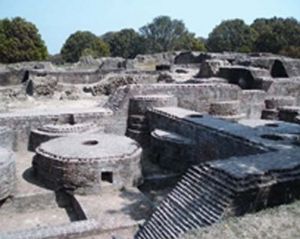Gaur Palace
Gaur Palace was built by successive rulers during the Sultanate period and lies within the citadel to its south-western part. Now in ruins, and almost obliterated, it is surrounded by the popular baixgaji (22 yards) wall, so named because of its great height, literally 'twenty-two yards'. The wall now stands in four segments - three on the east and one on the north pronouncing its great strength in width and height, and showing the general character of mediaeval fortification in Bengal.

Probably originally built by Sultan nasiruddin mahmud shah (1435-59 AD.), the restorer of the Iliyas Shahi dynasty, the palace continued to be used throughout the Sultanate period. The existence of the Lukochuri gate and other Mughal remains within the fort suggest that even the Mughal governor shah suja used it.
As is apparent from the ruins, the palace consisted of three courts divided by parallel walls running east to west. A comparison with other extant remains of Muslim palaces throughout the Islamic world suggests that the first court from the north was the official part or the darbar. Local tradition, however, remembers this court as the Khajanchi Khana or the treasury house. Since the palace was entered from the north through the dakhil darwaza, and thence through the Chand and the Nim Darwaza, there can be little doubt about this court's being used for the reception of public or foreign dignitaries. In the famous Alhamra Palace (a 14th century construction) of Spain, a hall in a similar reception was called the hall of the ambassadors. The second and the third courts are generally recognised as private and ladies' quarters respectively. In the Alhamra these courts are designated for similar purposes. There is, however, a difference. While with the courts in the present palace was a tank, the Alhamra courts had a fowara (fountain) in with spouting jet instead.
The division of the palace into two or three courts was a tradition that developed from early Islamic times, perhaps from the Umayyads in the early 8th century. This tradition continued unabated throughout the subsequent centuries. In India, Bengal's contribution in its development, as it appears, was the excavation of the tank within (which because of the geological and climatic condition was unthinkable in Middle East or Northern India). The tank in the first court has a local appellation, the Takxal Dighi (tank of the mint) to conform probably to the name Khajanchi Khana. A watercourse running underneath the palace to the Nim Darwaza is mentioned in an inscription of Sultan barbak shah who, according to it, constructed the gateway in 871 AH (1466 AD). A part of the inscription 'Behold a water-course, flowing under the palace, resembling Salsabil (paradise) shows how much importance was given to 'running water', a promised reward in the scripture for the virtuous in the next world. [ABM Husain]
